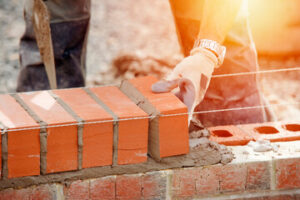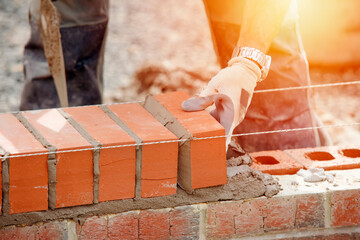Using masonry materials, Brick Masons Charleston SC construct and repair walls, partitions, arches, sewers, and other structures. Their duties include:
- Reading blueprints and plans, marking reference points, cutting materials, mixing and applying mortar.

Masonry workers should have excellent problem-solving skills to deal with challenges that arise on construction sites. They must also follow safety protocols and adhere to construction schedules.
A brick mason works with masonry materials like bricks, stones, and concrete blocks to build structures. He or she may also be responsible for repairing or restoring existing masonry structures. Masonry is a time-consuming process, and masons must be able to work efficiently in order to meet construction deadlines. Typical job duties include reviewing blueprints, measuring and cutting materials, mixing mortar, laying bricks, and cleaning surfaces at the end of each day.
Brick masons use a variety of tools and machines to complete their work. These include mortar mixers, power tools, and a trowel. They may also use a spirit level and string line held down with pins to ensure that their walls are level and straight. Masons must also have a hammer and chisel for cutting bricks to fit around windows or doors. Depending on the project, brick masons may also need to apply a sealant or other protective coating to the finished product.
While brick masons typically focus on building walls, they can also build other types of masonry structures, such as patios and sidewalks. These structures are usually made from clay bricks or concrete block, and can be finished with different colors and textures. Some masons also specialize in paving brickwork, which involves using different patterns and designs to create beautiful and durable outdoor surfaces.
Masons can also work with other types of masonry materials, such as granite, marble, limestone, and tile. These materials are often used in commercial construction, such as office buildings and shopping centers. Some masons may even work on industrial projects, such as power plants and factories. These projects require specialized materials that can withstand high temperatures and heavy loads.
Cutting brick is an important skill for brick masons to have. They often work with a range of tools and machines to cut and shape bricks for construction projects. They may also be responsible for repairing and restoring existing brick structures. Their duties include reviewing blueprints and plans, spreading mortar, and working closely with other professionals to ensure that the brickwork aligns with the project specifications.
Masons use various hammers and cutting tools to fit bricks into building corners, windows, and other openings. They may also need to cut bricks with a saw to fit them into odd shapes and angles. These tasks require precise measurements and knowledge of different bonding patterns, such as running and Flemish. Masons must also be able to estimate how much brick they need for a specific job.
To prepare the brick for cutting, they should first mark the desired line with a pencil or chalk. They then score the brick along the line with a hammer and chisel. This step is important because it helps the brick break cleanly and prevents a jagged cut. The chisel should be used with a good amount of force to ensure that the brick breaks cleanly.
There are many ways to cut brick, but the most common is to use a masonry saw. This tool is designed to cut both mortar and brick, but it can be difficult to use unless you are an experienced mason. If you choose to use a circular saw, it should be fitted with a masonry blade. Otherwise, it may cause a lot of dust and debris. If you don’t have a masonry saw, you can use an angle grinder with a stone cutting wheel.
Brick masons use their skills to transform architectural designs into tangible constructions. They collaborate with other professionals such as architects, engineers, contractors, and construction workers to ensure that their work aligns with the design and meets the required standards. They also repair and restore damaged or deteriorated brick structures. This can involve removing and replacing individual bricks, repointing mortar joints, and restoring the structural integrity of the structure.
To begin a brick project, masons prepare the working area by laying a foundation and building scaffolds. They also lay a bed or layer of soft mortar on the base and then set each brick into place. They can use various bonding patterns, such as running or Flemish, depending on the project plans. They may need to cut and shape bricks, such as for curves or corners, using chisels or power tools. They also calculate the quantity of bricks and mortar needed for a particular project, taking into account wall dimensions, bonding patterns, and waste allowance.
Brickmasons must be able to read and interpret blueprints, which they use to understand the overall structure of a project. They may need to use measuring devices, such as a tape measure and level, to determine the exact size of each brick. They also need to ensure that the walls are built in a straight line and that they follow a specified pattern. They also check the location and position of openings such as doors, windows, and vents.
Masons must also adhere to safety protocols and wear personal protective equipment on the job site. They also need to know how to operate heavy equipment such as dump trucks, backhoes, and bobcats. They must also be familiar with the use of brick, concrete blocks, and natural and artificial stone.
Brick masons use mortar to bond brick, concrete blocks, stone and other construction materials together. The work is typically outdoors and requires them to follow strict measurements and specifications. Masons often collaborate with other construction professionals, including architects and engineers. This requires effective communication and teamwork skills to ensure the work meets all requirements.
Masons typically work with clay brick and concrete block, but they can also work with terra cotta, marble, granite and other natural stones. They must have well-rounded training, usually through an apprenticeship, in all phases of brick and stone masonry, including building, aligning, and joining the units.
A successful masonry project depends on the quality of the mortar used. The mason must choose the right mix of ingredients, ratios and sand type to get the best results. This is particularly important in warm weather, when the mortar can “flash set” and become unusable. In this case, the mason should add a retarder to the mixture to slow down the hydration process.
The mason must also consider the size and shape of the bricks he or she is using. Large bricks require a thicker mortar than smaller ones, and it is important to keep this in mind when mixing the mortar. It is also a good idea to use a trough or wheelbarrow to make the job easier.
The mason must also use a mudboard to mix the mortar. This is a large board that has been specially designed to hold and distribute the mortar. He or she must also ensure that the mudboard is clean to prevent contamination of the mortar. Finally, the mason must use a trowel to apply the mortar in a brick wall or structure.
Brick masons use mortar to join and support brick walls, foundations, and other structures. They apply it using trowels and power saws, and may also use mortar mixers to prepare large batches of the material. They must follow safety precautions to protect themselves from injury or exposure to harmful materials.
Masonry is a skilled trade that requires attention to detail. Brick masons must be able to read plans or blueprints and calculate the amount of material required for each job. They must also be able to cut bricks and other materials to size. They are also responsible for mixing and spreading mortar and cleaning the work area at the end of each day.
Once the mason has prepared the foundation, they begin laying bricks or blocks to create the structure. The mason begins with the corners of the foundation or floor slab and moves outward, laying each course in order from corner to corner. The first course is laid dry to allow a visual check of the dimensions against the plan, and the mason must make sure that it is level. A closure block is then placed in the final corner, and mortar spread around the edges of the opening and across the face of the closure to ensure a strong bond.
Mortar is typically made of a mix of Portland cement, sand, and water. Different ratios of each ingredient result in different strengths of mortar. Masons often use type S or N mortar, which is designed for general construction. Other types of mortar include type K, which is softer and has a low compressive strength, and type HT, which is used for high-heat applications such as fireplaces or chimneys.
